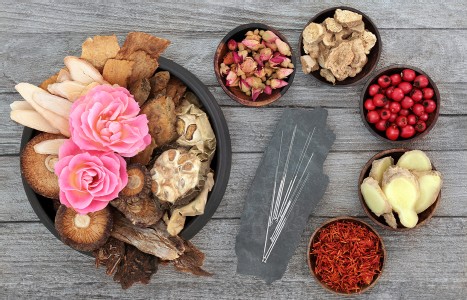Did any of you ever get the feeling in school that it simply was not OK to speak about wanting to be successful? To get into the nitty gritty details of how to make money in practice? Maybe you were even someone like me who was directly told by someone in a position of power that I needed to take what I could get because in private practice, I wouldn’t make money.
Summary of the AAOM Presidents Roundtable
The Process
 The AAOM conducted the President's Roundtable using a unique electronic voting process at the 2004 annual meeting. The free session was offered with NCCAOM CEUs to encourage conference participants to come and contribute ideas and feedback to AAOM's strategic planning process. AAOM leadership elected to pursue this format as a creative way to improve opportunities for democratic participation by members and non-members. Typically, the President's Roundtable involves only presidents of the state organizations; since the technology provides an ability to sort the opinions of various groups, the AAOM leadership decided to open the process to other parts of the AOM community.
The AAOM conducted the President's Roundtable using a unique electronic voting process at the 2004 annual meeting. The free session was offered with NCCAOM CEUs to encourage conference participants to come and contribute ideas and feedback to AAOM's strategic planning process. AAOM leadership elected to pursue this format as a creative way to improve opportunities for democratic participation by members and non-members. Typically, the President's Roundtable involves only presidents of the state organizations; since the technology provides an ability to sort the opinions of various groups, the AAOM leadership decided to open the process to other parts of the AOM community.
The meeting was co-facilitated by Chuck Anders, president of Strategic Initiatives, and Adam Burke, PhD, MPH, LAc, Professor of Health Education/Holistic Health at San Francisco State University. Each participant had an electronic handheld voting device, provided by Strategic Initiatives. As questions were posted on the screen, participants entered a vote on their keypads. These anonymous votes, expressing agreement or disagreement, were then projected back onto the screen. The results of the voting could immediately be broken down by demographics, such as years in practice, region of country, and training.. The real-time data analysis and group comparison allowed for dynamic conversations to occur in areas such as herbal
access and legislative support for states from the AAOM.
Summary Findings
Participants were asked questions in a number of areas critical to the profession. Results are presented below.
Participant Information
The 60 participants represented a very diverse cross-section of the profession: gender 40/60% female/male; average age of 44; ethnicity -- Asian 17% (Korean 2%, 15% Chinese), Black 2%, Hispanic 2%, White 73%, Other 6%. Participants represented the entire U.S., although a larger percentage were from southwestern states. There were both new and seasoned practitioners in the audience: 0-2 years practice (18%), 2-5 years (10%), 5-10 years (25%), 10-15 years (16%), and 15+ years (31%). Professional training included: LAc, 37%; MAc, 31%; OMD, 16%; MD, 5%; RN, 3%; PharmD, 1%; other, 11%. Approximately 26% possessed some type of doctoral degree, not necessarily AOM-related, however. Forty-three percent of the participants belonged to various state associations, 37% were AAOM members, and 20% had other AOM professional affiliations. Participation in those professional groups included: 26% board members; 21% presidents; 21% AOM administration and staff; 18% AOM faculty; 9% students; and 4% vendors.
Key Information
After gathering participant demographic data questions, topics perceived to be critical to the profession were presented. The session facilitators collected questions from AAOM leadership who did outreach to state association members and general AAOM membership via e-mail. The final list of key topics included: professional unification, herb access, reimbursement issues, education, employment opportunities, and professional practice. The primary findings and the final session evaluation information follows.
1. Professional Unification
Participants unanimously agreed that the profession needed a national lobbying presence in Washington (100%). They felt that a national unification process, which allowed all associations to communicate effectively and share resources, was very important for the profession (87%). The majority of participants were interested in the professional activities of other states (80%), and they agreed that AAOM assistance in raising state association memberships (83%) and helping to work on state legislative issues (75%) would be helpful. It was a common sentiment that participation in state association activities was generally inadequate (89%), due primarily to "not understanding the risks" of non-involvement (33%) and "lacking understanding of how state associations protect the profession" (37%).
2. Access to Herbs
The majority of participants (87%) believed that the AAOM should actively assist individual state associations in adding herbs to their scope of practice. In addition, 68% agreed that the AAOM should work with federal agencies to protect access to herbs, primarily through negotiations with the FDA.
3. Reimbursement Issues
The majority of participants (82%) believed that the AAOM should use legal, or other means, against insurers who refuse to pay for acupuncture, and that the AAOM should support the bifurcation of the Hinchey Bill (73%). (This is a Medicare bill that combines the Federal Employee Benefits packages with Medicare. The audience received explanation on the strategy prior to voting.)
4. Education
The majority of participants agreed with the ACAOM Doctoral Task Force recommendation that the profession would most likely eventually adopt a professional doctoral degree (82%). However, 73% believed that a doctoral title should be the standard title for the profession. In addition, 73% agreed that the AAOM should assist states with legislative efforts to standardize educational requirements in acupuncture and Oriental medicine, as these standards apply to other health care professionals who can legally practice acupuncture, such as MDs and chiropractors.
5. Employment Opportunities
The majority of participants believed that the AAOM should establish a process to assist new practitioners with clinical and business practices questions, and also provide online services related to the sale of practices, jobs available, and jobs wanted (78% and 76% respectively).
6. Professional Practice
In this section, participants were asked to rank key priorities at the state and national levels. First, they ranked key state issues from a list of five common concerns. Second, the participants ranked items in a list of AAOM organizational priorities. Finally, they ranked AAOM's performance on these same organizational priorities.
State Issues
AAOM leadership proposed a list of five key issues viewed as important state AOM association issues. These items were presented in a list and the participants were asked to rank them in terms of relative importance. The participants' rankings are given here. The percentage following each item gives the percentage of participants who ranked that item as first, second, and so on.
- Herb access -- 72%
- Scope of practice -- 62%
- Insurance reimbursement -- 52%
- Doctoral title by license -- 35%
- Licensure reciprocity -- 26%
Relative Importance of AAOM Organizational Priorities
The participants were then given a list of 15 items that represent possible AAOM organizational priorities. The list was presented and participants were asked to rank one item versus the other. The final prioritized list as selected by participants is given here. The percentages shown reflect the number of participants who ranked that item higher than the others. A visual examination of the data suggested three potential organizing principles (added after analysis): strength and visibility, business opportunities, and professional development.
I. Strength and Visibility
Legislative representation, at the national level -- 57.6%
Marketing and PR, promoting state/national public awareness -- 55.9%
Herbal practice, promoting, protecting, redefining -- 55.2%
National unification, uniting the profession -- 47.5%
Legislative representation, at the state level -- 41.4%
II. Business Opportunities
Protect/develop professional practice, e.g. non-medical acupuncture licensure requirements -- 39.7%
Reimbursement issues, such as insurance and workman's compensation -- 33.9%
Pre-professional education, such as advocating for doctoral status -- 33.3%
Research, sponsoring or promoting AOM research initiatives -- 32.2%
Professional status, promoting AOM and its professional status within health care community -- 30.5%
Business development resources, providing support for successful business practice -- 28.8%
Employment opportunities, working to create jobs in health care -- 23.7%
III. Professional Development
Professionalism, promoting the sophistication/maturation of the profession -- 18.6%
Professional education, providing CEUs and professional development -- 17.5%
Improved communication, between acupuncturists and professional organizations -- 13.8%
Performance by AAOM on Achieving Organizational Priorities
Finally, the same 15 items were presented to participants who were then asked to rank these items in terms of perceived performance by the AAOM in each of these areas, from most to least effective.
Most Effective
- Professional education, providing CEUs and professional development
- Herbal practice, promoting, protecting, redefining
- Pre-professional education, such as advocating for doctoral status
- Professionalism, promoting the sophistication/maturation of the profession
- Protect/develop professional practice, e.g. medical acupuncture, licensure requirements
- Legislative representation, at the national level
- Professional status, promoting AOM and its professional status within health care community
- Improved communication, between acupuncturists and professional organizations
- National unification, uniting the profession
- Research, sponsoring or promoting AOM research initiatives
- Legislative representation, at the state level
- Business development resources, providing support for successful business practice
- Reimbursement issues, such as insurance and workman's compensation
- Marketing and PR, promoting state/national public awareness
- Employment opportunities, working to create jobs in healthcare
Least Effective
Meeting Evaluation
Finally, a set of questions was posed at the conclusion to evaluate the session, the process, the conference and the AAOM's overall performance. The majority of participants (90%) said that they would like to see more of these types of decision making processes in the future; 74% found the session useful or very useful in exploring issues important to your professional future; 87% found the interactive technology to be useful or very useful; 86% reported that the conference overall was useful or very useful; and the majority of participants (88%) believed that the AAOM was working in the best interest of the profession, with 12% disagreeing.
Conclusion
The interactive session was viewed as an important process in the development of a stronger, more unified profession. The information gathered provides useful preliminary material for strategic planning purposes, and the beginnings of a national vision that reflects the ideas of diverse participants, rather than one or two agendas. It is clear that the group sample was small, and therefore the data does not necessarily reflect AAOM membership or the AOM community at large. The data does, however, reflect a good mix of practitioners, teachers, administrators and students, old and new practitioners, men and women, and diverse ethnicities from around the country. Although this is a beginning, it is a crucial activity, bringing the profession together to protect what we have and to build an even stronger foundation for the future.
A great deal of attention has been paid in recent years to issues of education, such as the doctoral status question, which is exemplified by California's Little Hoover Commission activities. However, many voiced an opinion that there are more pressing issues facing this profession, specifically, protecting and promoting traditional acupuncture and oriental medicine, as practiced by licensed professional AOM providers. The voice of the participants heard in this process reflects the belief and recognition that there is strength in numbers; that national unification and political vitality are essential; and that we must increase the visibility of our profession and the recognition of its efficacy and essential uniqueness.
AAOM considers this historic event to have served its purpose well. There was a pervasive sentiment from those participating that greater involvement from the diverse interests comprising our profession is essential. Although a humble beginning, this is an important beginning, reflecting what will become a much greater effort to build a cohesive, empowered voice for this profession.


